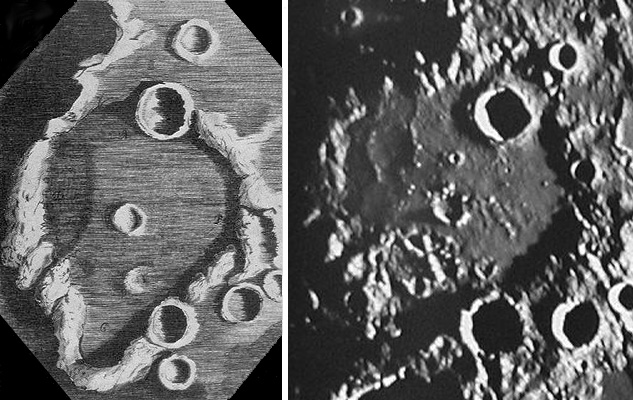Difference between revisions of "January 31, 2004"
| Line 18: | Line 18: | ||
<table class="story" border="0" bgcolor="#FFFFFF" width="90%" cellpadding="10" align="center"><tr><td> | <table class="story" border="0" bgcolor="#FFFFFF" width="90%" cellpadding="10" align="center"><tr><td> | ||
<p class="story" align="center"><b>Hooke & Hipparchus</b></p> | <p class="story" align="center"><b>Hooke & Hipparchus</b></p> | ||
| − | <p class="story" align="left">The earliest drawings of the Moon were of the [LPOD-2004-01-01.htm entire body]. By 1665 Robert Hooke, the | + | <p class="story" align="left">The earliest drawings of the Moon were of the ["LPOD-2004-01-01.htm" entire body]. By 1665 Robert Hooke, the |
English rival of Isaac Newton, published (in his Micrographia) the first drawing of a single feature, and it was | English rival of Isaac Newton, published (in his Micrographia) the first drawing of a single feature, and it was | ||
remarkably accurate. The comparison of Hooke's drawing of the 150 km wide crater Hipparchus with a modern photo taken | remarkably accurate. The comparison of Hooke's drawing of the 150 km wide crater Hipparchus with a modern photo taken | ||
Revision as of 20:58, 4 January 2015
Hooke & Hipparchus
Image Credit: Ingenious Pursuits & Consolidated Lunar Atlas |
|
Hooke & Hipparchus The earliest drawings of the Moon were of the ["LPOD-2004-01-01.htm" entire body]. By 1665 Robert Hooke, the English rival of Isaac Newton, published (in his Micrographia) the first drawing of a single feature, and it was remarkably accurate. The comparison of Hooke's drawing of the 150 km wide crater Hipparchus with a modern photo taken with a 61" telescope (Consolidated Lunar Atlas sheet E10) shows that Hooke correctly drew many details including two mountainous ridges at the bottom left. Hooke also shows a shadowed arc on the left side of Hipparchus that represents part of a ghost crater and various small hills. Hooke make this drawing with a 30 ft focal length telescope but he never gave the diameter of its lens. He was a very keen-sighted observer, discovering that Jupiter rotates and discovering Syrtis Major on Mars. Hooke was one of the most versatile scientists of the 17th century - I eagerly await the new biography of him by the wonderful author Lisa Jardine. Related Links: Tomorrow's LPOD: Theophilus |
Author & Editor: Technical Consultant: A service of: |
COMMENTS?
Click on this icon File:PostIcon.jpg at the upper right to post a comment.




